And it is not just Minnesota’s government building momentum around an alternative energy future. The state’s Fortune 100 companies, such as Target and Best Buy, have set significant GHG reduction goals. Its power companies continue to expand renewable generation, including both solar and wind. And Minnesota’s civil society, pillared by organizations such as Great Plains Institute and Center for Energy and Environment, helps facilitate change and drive innovation in the energy and efficiency sector. That is why RMI was excited to support the Minnesota Department of Commerce in the development of a comprehensive guide to conducting an energy future study for Minnesota.You can imagine that somewhere in the faraway, fictional land of Lake Wobegon, solar panels are appearing atop barn roofs and wind turbines are gracing ridge lines.
A roving compendium of ecocentric energy options, including advances in solar and wind power, hybrid vehicles, and other thoughtful, balanced approaches to renewable energy.
Showing posts with label wind turbines. Show all posts
Showing posts with label wind turbines. Show all posts
Sunday, March 30, 2014
New Energy Strategy for Minnesota Evaluates Renewables
A new article in the RMI Outlet looks at a comprehensive evaluation in Minnesota to assess the value and potential of renewable energy resources to replace the infrastructure heavily dependent on fossil fuels. The move has elicited some corresponding excitement from businesses in the state.
Saturday, April 09, 2011
Houston embraces renewable energy
Houston serves as an excellent model for moving away from fossil fuels and nuclear power to a genuinely clean, infinitely renewable approach to meeting a major city's energy needs.
Friday, March 04, 2011
Designers find ways to tap wind power almost anywhere

A gizmag post, Power Flowers to domesticate wind turbines, explores the potential of the product of a Dutch design house, Nl Architects, to tap wind power closer to where it is needed.
While most of us will offer strong vocal backing for the construction of wind farms, that can soon change if someone suggests building one nearby. As a result, the tri-blade towers get exiled to the middle of nowhere – or even further away. Instead of having a few high performance giants scattered throughout the land, NL Architects proposes a structure that would bring a few less efficient turbines together and place them closer to the users of the power they generate.
The efficiency of the vertical-axis turbines used in this design is less than tri-bladed turbines, but more can be situated in a given location. The technology looks promising and deserves more investigation.
Labels:
energy,
renewable energy,
sustainability,
wind,
wind turbines
Thursday, October 21, 2010
Solar power creates electric grid challenges in Germany

The accelerating adoption of solar panels in Germany looks like a case of too much of a good thing. The antiquated power grid across the country is having trouble coping with the fluctuations resulting from feed-ins from photovoltaic systems and wind turbines.
As reported in this UPI.com news story:
Experts have long called for an overhaul of the European power grid to integrate the fluctuating renewable energy sources such as solar and wind power.
Experts forecast between 8 gigawatts and 10 GW of solar power capacity to be installed this year -- the equivalent of roughly 10 large coal-fired power plants. In 2009, only 4 GW were installed.
With an equally fragmented and outdated power grid, the U.S. would do well to overhaul its own infrastructure in preparation for more extensive use of renewable energy. Google's investment in the Atlantic Wind Connection is a step in the right direction.
Saturday, January 09, 2010
Accelerating Wind Power in the UK

While the US effectively twiddles its collective thumbs on the issue of offshore wind power (with installations such as Cape Wind Project in Nantucket Sound endlessly delayed), the UK is forging ahead with a massive investment in offshore wind farms. The British government has approved the building of wind farms in nine development zones capable of generating more than 32 gigawatts of power, as detailed in this article from the Environment News Service.
Justin Wilkes, policy director of the European Wind Energy Association, said the projects announced today, once built, "will multiply by 10 Europe's offshore wind energy capacity."
"These are European companies building a European industry and generating some 45,000 European jobs. It takes Europe closer to exploiting the power of our seas and developing a brand new European offshore wind industry," said Wilkes. "Offshore wind is Europe's largest untapped energy source. There is enough wind across Europe's seas to power Europe seven times over."
The power that will be generated by the developments announced today is part of the more than 100 GW of offshore wind power currently being planned by European utilities, developers, and governments, mostly in the North Sea.
Proposed projects in the US, as shown by this map created by OffshoreWind.net, show potential, but we lag significantly behind the European countries that have installed wind turbines offshore.
Wednesday, January 06, 2010
Derailing Wind Energy Progress
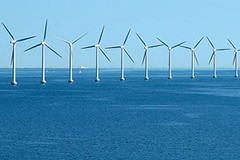
The basis of our American experiment in democracy has always been predicated on following the will of the majority while respecting the positions of the minority. As a recent Mother Jones article (Cape Wind Delay a Big Win for Dirty Energy Interests) points out, the democractic process has been turned on its ear by an unlikely alliance of oil and gas interests with a group of Native Americans who are looking to define an entire body of water as a national historic site, blocking the construction of the Cape Wind Project on Nanucket Sound.
Journalist Kate Sheppard notes:
The tribes surely have perfectly sound reasons of their own for opposing the project. "We are hoping...that we can protect the sound and our religious right to worship the rising sun and be able to pass that tradition on to our grandchildren," Green said. "The government has not honored many of the things it has promised to the Native American people...All we have is the process, and all we've asked for is due process."
That's clearly a consideration for the Department of Interior, which oversees NPS. To that end, the Interior Department recently issued a new tribal consultation policy, a long overdue effort to improve the agency's relationship with tribes.
But in the case of this particular decision on Cape Wind, granting this level of preservation to an entire body of water could be a bad omen for all future offshore wind development. Barring development here, Cape Wind president Jim Gordon told Mother Jones recently, "would have a chilling effect on what could possibly be one of the most promising sources for energy independence and creating a new green economy."
The forces aligned against renewable energy use every tactic imagineable to derail progress on the alternative energy front. In this case, the majority of the residents of Massachusetts, the state legislature, the state's congressional delegation, and the Governor, Deval Patrick, are solidly behind the Cape Wind project. The opposition is small, well-funded, and determined--undettered by what their opposition means to the future of energy development or the absolute necessity to reverse global warming. In this particular scenario, democracy isn't working very well at all.
Sunday, August 23, 2009
New Wind Energy Milestone: 4,000 megawatts in Six Months
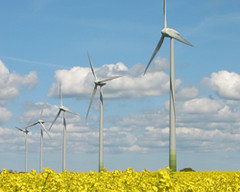
The wind-power juggernaut continues, with a promising new milestone announced by the American Wind Energy Association (AWEA) and reported by Consumer Reports.
AWEA CEO Denise Bode commented:
“The numbers are in, and while they show the industry has been swimming upstream, adding some 4,000 MW over the past six months, the fact is that we could be delivering so much more,” said AWEA CEO Denise Bode. “Our challenge now is to seize the historic opportunity before us to unleash this entrepreneurial force and build up an entire new industry here in the U.S. that will create jobs, avoid carbon, and strengthen our energy security. To achieve that, Congress and the Administration must pass a national Renewable Electricity Standard (RES) with strong early targets.”
Among the states that added substantial new generating capacity are Texas (454 MW), Iowa (160 MW), and Missouri (146 MW). Manufacturing investment in the U.S., however, is not as strong as in other countries, such as China, according to Bodine.
Labels:
alternative energy,
efficiency,
electricity,
energy,
environment,
power,
wind,
wind turbines
Sunday, March 01, 2009
Beyond the Stimulus: A Global Green Deal

With indications that global warming is accelerating faster than many earlier computer models predicted, you would think that this information would spur a concerted global effort to reverse the trend. But so far the response of most governments around the world has been fairly tepid and the levels of greenhouse gas emissions continue to rise in those countries most responsible for the problem.
In a recent article for The Nation, A Global Green Deal, Mark Hertsgaard makes a case for a massive program of green investment to lift people out of poverty, stimulate the worldwide economy, and reduce greenhouse gas emissions.
Hertsgaard believes the Obama's stimulus package is a good start, but more most be done to contend with the problem.
The stimulus package is a good start. It contains $71 billion in direct green spending and $20 billion in green tax incentives, according to an analysis by the Center for American Progress. The World Resources Institute has calculated that every $1 billion in green spending generates approximately 30,000 jobs, so the green portions of the stimulus package should create about 2 million jobs, many in the construction sector, which has been hit especially hard. Retrofitting buildings, installing solar panels and constructing wind farms require skilled and semiskilled labor and create decent-paying jobs that cannot be outsourced. Investing in climate-friendly development in poor countries, where money buys more, should yield even more jobs and economic uplift--no small consideration, given the recent warning from the US director of national intelligence, retired Adm. Dennis Blair, that the economic downturn could become the gravest threat to international stability if it triggers a return to the "violent extremism" of the 1930s.
But even more will have to be done, at home and abroad, if we are to slash emissions quickly enough to preserve a livable planet. President Obama has promised to reduce US emissions to 1990 levels by 2020 and to 80 percent below 1990 levels by 2050. This sounds impressive compared with the Bush/Cheney years, but precisely because of Bush-era foot-dragging, the United States and the rest of the world need to achieve larger and faster emissions reductions than previously assumed. We have "a very short window of time," Rajendra Pachauri, chair of the Intergovernmental Panel on Climate Change, said in January at a Worldwatch Institute conference. If we want to avoid such scenarios as twenty feet of sea-level rise, which would put most of the world's big cities under water, the rise in global temperatures must be limited to 2.0 to 2.4 Celsius above preindustrial levels. That means global emissions must peak by 2015 and then fall rapidly for decades, said Pachauri. In this context, he added, Obama's goal "falls short of the response needed by world leaders" in preparation for the negotiations in Copenhagen in December to produce a successor to the Kyoto treaty. Instead, Pachauri urged Obama to embrace the European Union's target: reducing emissions to 20 percent below 1990 levels by 2020, which the EU says it will achieve by increasing energy efficiency and renewable energy by 20 percent.
The article then charts a course for a more effective approach to reducing greenhouse gas emissions, including techniques through which energy efficiency alone can produce substantial reductions in emissions while producing strong economic development.
The data and the incentives make it clear that there is no time left for dawdling. Fortunately, the actions that have the best chance to mitigate climate disruption are actions that also have the potential to revive a stagnant worldwide economy.
Thursday, February 12, 2009
Grid? We don't need no stinkin' grid. . .

Power Plant at Sunset
Originally uploaded by lady_lbrty
A recent guest post in the New York Times by Amory B. Lovins of the Rocky Mountain Institute speaks to a theme that is becoming increasingly prevalent in energy discussions: the advantages of distributed generation. Putting clean, small-scale power plants close to where the energy is needed makes more sense than building mammoth power plants, rebuilding the nationwide electrical grid, and then distributing electricity over hundreds of miles.
The core of the argument goes like this:
Bigger power plants’ hoped-for economies of scale were overwhelmed by diseconomies of scale. Central thermal power plants stopped getting more efficient in the 1960’s, bigger in the 1970’s, cheaper in the 1980’s, and bought in the 1990’s. Smaller units offered greater economies from mass production than big ones could gain through unit size. In the 1990’s, the cost differences between giant nuclear plants — gigantism’s last gasp — and railcar-deliverable, combined-cycle, gas-fired plants derived from mass-produced aircraft engines, created political stresses that drove the restructuring of the utility industry.
Meanwhile, generators thousands or tens of thousands of times smaller — microturbines, solar cells, fuel cells, wind turbines — started to become serious competitors, often enabled by IT and telecoms. The restructured industry exposed previously sheltered power-plant builders to brutal market discipline. Competition from a swarm of smaller electrical sources and savings created financial risks far beyond the capital markets’ appetite. Moreover, the 2008 Defense Science Board report “More Fight, Less Fuel” advised U.S. military bases to make their own power onsite, preferably from renewables, because the grid is vulnerable to long and vast disruptions.
Lower risk energy projects constructed on a human scale have a greater chance of success than past-generation mega power plants. The market is swiftly coming around to recognize this fact.
Monday, February 02, 2009
From a Fossil-Fuel to a Green Economy
From Nation videos, some thoughts on the benefits of moving from an economy based on fossil fuels to one that generates jobs though solar projects, wind energy, and energy efficiency.
Labels:
alternative energy,
efficiency,
electricity,
energy,
environment,
heating,
job growth,
labor,
microgeneration,
oil,
peak oil,
renewable energy,
solar,
wind,
wind turbines
Thursday, January 29, 2009
The Distributed Generation Approach
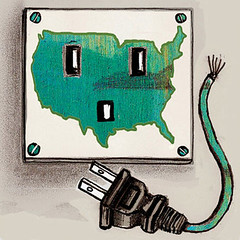
We've grown up in a country where when you flipped the switch on the wall to light a lamp, the electricity came from a power source dozens or maybe hundreds of miles away. This centralized model of power distribution is beginning to give way to a smarter approach: distributed generation. Small wind farms, solar installations for a building or apartment complex, co-generation systems that heat a neighborhood, geothermal deployments that heat in the winter and cool in the summer.
In this article in The Nation, Think Solar, Think Small, Craig Rosen builds a case for abandoning the grand notions of a national backbone grid in favor of small-scale, community-oriented power generation. He writes:
To be sure, the romance of a renewable national grid is classic American thinking: a big problem requires a big solution. But the distributed generation approach (DG in energy lingo) is emerging from advances in solar technology and detailed studies of alternatives to big power-line projects. Consider what happened when Minnesota regulators looked carefully last year at the CapX 2020 project, a proposed cluster of new power lines costing up to $1.7 billion. A key purpose of the lines was to link Minnesota with proposed wind farms in the Dakotas. This is just the type of project favored by Pickens and other supporters of big electric transmission. But after examination the regulators found that Minnesota could develop many small 10-40 megawatt wind farms within the state totaling 600 megawatts--equivalent to a modern power plant--without any new transmission.
"We call it the '600 megawatts for nothing' study," said Mike Michaud, an engineer and consultant who formerly worked with the state regulatory staff. "There was no denying there were twenty spots on the existing grid [where] you could put generation for no cost at all." Michaud added that there is no guarantee the $1.7 billion transmission project would be restricted to clean power--it might in some cases be used to transport power from coal-burning plants.
He mentions a study by the Institute for Local Self-Reliance that determined half the states in the U.S. could be energy self-sufficient by harnessing renewables within their borders, satisfying a considerable fraction of their own energy needs.
Powerful food for thought...
Saturday, January 24, 2009
Renewable Energy in the 21st Century
One of the refreshing parts of the following independent short, Unlimited: Renewable Energy in the 21st Century, is the perspective of the young people interviewed. If there is hope for the human population of this harried planet, it's in the upcoming generation's unvarnished, unblinkered viewpoints.
Friday, January 09, 2009
Global Perspective on Green Stimulus Packages
The U.S. isn't the only country determined--under Barack Obama's leadership--to get its economy rolling through stimulus packages to produce alternative energy. This piece, from LinkTV, offers a concise view of what some other countries are doing in this area.
Thursday, December 11, 2008
Dr. Chu Proposes Clean Energy Solutions
Dr. Steven Chu, under consideration as Energy Secretary in the Obama administration, offered his thoughts on clean energy paths during a speech at the National Energy Summit in early December. He places a premium on energy efficiency and cites "existence proofs" demonstrating ways we can reduce energy use without reducing our national wealth. His keen awareness of the dire threat posed by climate change and understanding of the breakthrough technologies that offer our best bet for handling future energy requirements may lead us in a more promising direction--if he is appointed...
Thursday, September 11, 2008
Turbine Recycling
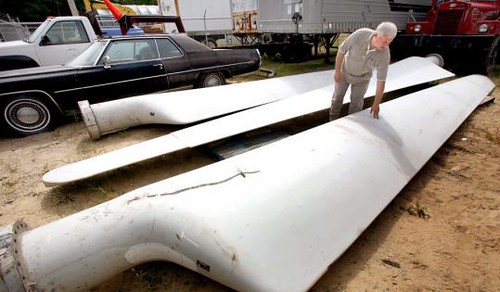
A Boston Globe article, Where turbines wind up to get their second wind, tells the story of a new twist on recycling. A company in Plymouth, Massachusetts, reburbishes aging wind turbines, repairing and replacing bearing, gear boxes, and generators, as required, to meet the growing need for wind power.
Brian D. Kuhn, the cofounder of Aeronautica, aims for the mid-level market, a niche that has significant potential for growth.
"The nice thing about this midscale market that we are concentrating on is these are not huge machines," said Kuhn, who hopes his company will be able to supply turbines to power schools, homes, or even supermarkets. Already, he says, several people with local projects in the works have called seeking equipment.
With backlogs on new wind turbines hindering deployments, Kuhn has built a business around the increasing popularity of wind as an energy source.
Labels:
electricity,
energy,
environment,
recycling,
renewable energy,
wind,
wind turbines
Monday, September 08, 2008
Using Wind to Power Cars
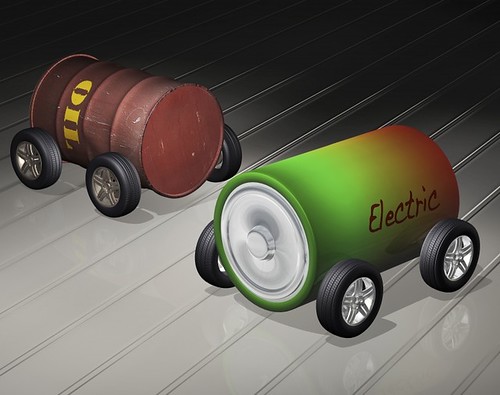
Lester Brown calls T. Boone Pickens to task for pushing natural gas as a vehicle fuel when using wind to recharge electric cars is a much more efficient process (and far easier to implement).
Brown gives Pickens credit for the wind power side of his argument in an opinion piece for The Capital Times, but sees no sense in the natural gas advocacy. In this piece, he asks:
Why not use the wind-generated electricity to power cars directly? Natural gas is still a fossil fuel that emits climate-changing gases when burned.
Plug-in cars are here, nearly ready to market. We just need to put wind in the driver's seat. Several major auto manufacturers, including GM, Ford, Toyota and Nissan, are producing plug-in hybrids. Both Toyota and GM are committed to marketing plug-in hybrids in 2010. Toyota might even try to deliver a plug-in version of its Prius gas-electric hybrid, the bestseller whose U.S. sales match those of all other hybrids combined, next year.
GM is in the game, too, with its Chevrolet Volt. This plug-in car is essentially an electric car with an auxiliary gasoline engine that generates electricity to recharge the batteries when needed. It boasts an all-electric range of 40 miles, more than adequate for most daily driving. GM reports that under typical driving conditions, the Volt averages 151 miles per gallon.
Brown goes on to say:
This new car technology is matched by new wind-turbine technology, setting the stage for an automotive-fuel economy powered largely by cheap wind energy. The Energy Department notes that North Dakota, Kansas and Texas alone have enough wind energy to easily satisfy national electricity needs. To actually put wind power on the road, of course, we would have to tap the wind resources in nearly all the states, plus those that are off-shore, which the department says can meet 70 percent of national electricity needs.
Who is right? I'm inclined to cast my vote in favor of Occam's Razor, or, as it is often paraphrased: All other things being equal, the simplest solution is the best. Wind-powered plug-in hybrids appear to be the simplest solution.
Monday, June 02, 2008
Finding the Ultimate Battery

Storing energy effectively lies at the heart of our contemporary quest for escaping fossil fuel addiction. Two of the most promising alternative energy sources, wind and solar, are inconsistent throughout the day or week or month. Without a means of capturing the energy so generated for those times when the sun doesn't shine or the wind doesn't blow, the potential is diminished. And the vast promise of electric cars hinges on the ability to extend their range sufficiently so you don't run out of power on the way home from work.
Lee Hart, a self-employed electrical engineer profiled in a recent Mother Jones article, A Charge to Keep, tracks the progress of battery technology from his basement lab. What he has learned in the course of rigorous testing is enlightening.
Britt Robson, the writer of this piece, nurses out the crux of the problem:
Hart has heard the dreamers wax on about a time when batteries will run for days on end, revolutionizing plug-in cars, windmills, and solar panels—just about any source of alternative energy would benefit from good batteries, which allow electricity to be stored and transported. He has sympathy for those visions. A motto of his hero, Thomas Edison, is inscribed on a favorite sweatshirt: "To invent you need a good imagination and a pile of junk." Like most electro-geeks who'd rather tinker than strut, he also adheres to Edison's practical DIY ethos, which explains the battery room and the small fleet of electric cars he has either retrofitted or built from scratch. His tests invariably reinforce what he and most everyone else familiar with the battery market have long known. When it comes to practical applications for sustainable energy, batteries are more of an Achilles' heel than a panacea, because we are running 21st-century technology with what is essentially 18th- or 19th-century chemistry.
Hart's work is leaning toward extending available battery power by creating light, structurally solid automobile frames, favoring efficiency over raw power.
But the main innovation in Hart's car has nothing to do with how it's powered—it'll be compatible with any kind of battery—but rather with its strong and lightweight frame, influenced by the ultraefficient "hypercar" philosophy of environmentalist Amory Lovins. "If I make the car lighter, I still get the fuel economy I'm looking for," notes Hart. In other words, for now, the best way to get more out of batteries is to simply demand less of them.
Improved efficiency could make a tremendous contribution to reducing our energy-consumptive habits, as has been thoroughly documented by the Rocky Mountain Institute, providing savings in home and business heating and cooling, industrial operations, and transportation. And even the variability of solar and wind power is not as straightforward as you might think, as this RMI article, Rethinking the Reliability of Solar and Wind Power, points out.
The solutions are out there, if only we'd take advantage of them.
Sunday, May 18, 2008
Generating Jobs, Producing Energy
The tired, old energy paradigms of the last hunded years and the fixation on fossil fuels do nothing for solving climate destabilization problems. In this interview produced by The Real News Network, José Etcheverry, an energy policy analyst for the David Suzuki Foundation, explains how renewable resources, including solar and wind power, encourage a decentralized energy model where individual communities benefit not only from cost-effective power, but jobs and a steady flow of revenues as well.
Thursday, April 10, 2008
Solar City in the Desert
Call it a proof of concept for solar energy or an example for the rest of the world. The self-sufficient Abu Dhabi solar city provides an intriguing model for other communities and a hint at the possibilities of solar energy in future applications.
Saturday, March 29, 2008
Wind Turbine Leader

When the OPEC crisis struck in the 70's, Denmark didn't waste any time seeking out new sources of energy. They immediately embarked on a nationwide initiative to develop wind power and they now own 40 percent of the global market. The country is also a mecca for bicyclists and during a typical commute in busy Copenhagen you will encounter more bicycles than cars.
The Toronto Star reports on the Danish proclivity toward efficiency, compact living arrangements, and smart engineering. When the national leadership falters, the municipal leaders step in.
But even as climate campaigners chide their national government's recalcitrance, most offer high praise for Copenhagen's municipal leadership, which has set itself an ambitious goal for 2015 to become what it calls the world's "Eco-Metropole" – the cleanest, greenest, lowest-emitting city on the planet.
"The things we've already achieved show us that Copenhagen doesn't need national legislation to go even further. We can do most of this on our own," said Klaus Bondam, the city's mayor of technology and the environment. "Cleaning up our harbour so that you can swim and catch cod fish, enhancing our cycling network to where it is today, becoming one of the first in the world to convert the wasted heat of electrical generation into heat for our homes – Copenhagen has done all this. And now we lead Europe. By 2015, we'll lead the world."
Among the city's goals is a plan to raise to 50 per cent the number of downtown commuters arriving by bicycle. The number seems otherworldly, until you consider that bikes comprise 36 per cent of downtown traffic, compared to only 27 per cent private automobiles.
To fully comprehend how such numbers are possible, the Toronto Star sought a history lesson from Dansk Cyklist Forbund – the Federation of Danish Cyclists – an organization launched in 1905 when the pressing issue of the day was punctures resulting from horseshoe nails littered along Copenhagen's network of horse paths.
"Here in Copenhagen, riding a bike is like wearing shoes," said DCF's Allan Carstensen. "It's normal. It's easy. It's convenient. People ride in their work clothes. And even the people in cars, the chances are they have a bike at home that they use regularly to run errands in the neighbourhood."
As the article points out, the dependence on coal is a sore spot in this picture, but positive steps are underway to lessen coal usage.
Subscribe to:
Posts (Atom)
